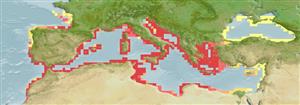Common names from other countries
>
Eupercaria/misc (Various families in series Eupercaria) >
Labridae (Wrasses)
Etymology: Symphodus: Greek, syn, symphysis = grown together + Greek, odous = teeth (Ref. 45335).
More on author: Linnaeus.
Environment: milieu / climate zone / depth range / distribution range
Ecologia
marino; salmastro associati a barriera corallina; distribuzione batimetrica 1 - 50 m (Ref. 121253). Subtropical; 47°N - 21°N, 11°W - 42°E
Eastern Atlantic: Spain to Morocco including the Mediterranean and Black Sea.
Length at first maturity / Size / Peso / Age
Maturity: Lm 11.7, range 12 - 15.2 cm
Max length : 44.0 cm SL maschio/sesso non determinato; (Ref. 3397); common length : 25.0 cm SL maschio/sesso non determinato; (Ref. 3397); Età massima riportata: 15 anni (Ref. 4742)
Short description
Chiavi di identificazione | Morfologia | Morfometria
Spine dorsali (totale) : 15; Raggi dorsali molli (totale) : 11; Spine anali: 3; Raggi anali molli: 12.
Adults are found near rocks mainly in eel-grass beds, sometimes in salty lagoons. Often gregarious. Oviparous (Ref. 205). Nest of seaweed built and kept by male with one or more females spawning. Feed on sea urchins, ophiuroids, bivalves, shrimps and crabs (Ref. 4742). Rate of growth is slow (Ref. 4742). Undergoes sex reversal (Ref. 4742).
Oviparous (Ref. 205). One male makes a nest of seaweed for one or more females to spawn in (Ref. 4742). Undergoes sex reversal (Ref. 4742).
Quignard, J.-P. and A. Pras, 1986. Labridae. p. 919-942. In P.J.P. Whitehead, M.-L. Bauchot, J.-C. Hureau, J. Nielsen and E. Tortonese (eds.) Fishes of the north-eastern Atlantic and the Mediterranean. UNESCO, Paris. Vol. 2. (Ref. 4742)
IUCN Red List Status (Ref. 130435)
CITES (Ref. 128078)
Not Evaluated
Threat to humans
Harmless
Human uses
Pesca: pesca di sussistenza; Pesce da pesca sportiva: si; Acquario: Commerciale
Strumenti
Special reports
Download XML
Fonti Internet
Estimates based on models
Preferred temperature (Ref.
115969): 16.3 - 21.4, mean 18.9 (based on 116 cells).
Phylogenetic diversity index (Ref.
82804): PD
50 = 0.5005 [Uniqueness, from 0.5 = low to 2.0 = high].
Bayesian length-weight: a=0.00933 (0.00783 - 0.01112), b=3.04 (3.00 - 3.08), in cm Total Length, based on LWR estimates for this species (Ref.
93245).
Trophic level (Ref.
69278): 3.3 ±0.3 se; based on diet studies.
Resilienza (Ref.
120179): Medio, tempo minimo di raddoppiamento della popolazione 1.4 - 4.4 anni (K=0.25-0.89(?); tm=2-3; tmax=15).
Fishing Vulnerability (Ref.
59153): Moderate vulnerability (40 of 100).
